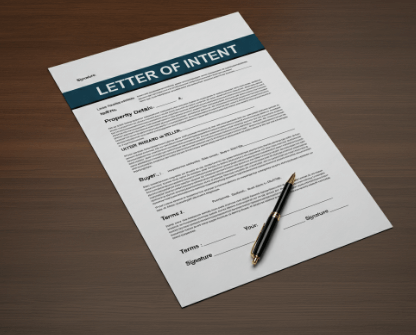What is a letter of intent in real estate? A letter of intent in real estate is a crucial document that outlines the initial terms and conditions of a potential agreement between parties, serving as a foundation for further negotiations. In the world of real estate, understanding the various documents and processes involved is key to successful transactions. One such crucial document is the letter of intent. Whether you’re a seasoned investor or a first-time buyer, grasping the significance of this document can pave the way for smoother deals. This blog post will explore what a letter of intent in real estate is, its importance, and how you can use it effectively.
Real estate investors like Steve Daria and Joleigh often use letters of intent to clarify the preliminary terms of a property transaction before entering into a formal agreement. This document serves as a blueprint for negotiations, ensuring both parties are on the same page regarding key points such as price, contingencies, and timelines. By outlining these crucial details early on, Steve and Joleigh can streamline the negotiation process and reduce misunderstandings.
What is a Letter of Intent in Real Estate?
A letter of intent in real estate functions as a preliminary agreement that lays out the essential terms and conditions agreed upon by parties interested in a property transaction.
While non-binding, it serves as a crucial framework for further deals and the eventual drafting of a legally binding contract.
This document usually includes details such as the purchase cost, financing terms, due diligence period, and any conditions precedent to closing, providing a foundation for formalizing the transaction.

Why Use a Letter of Intent?
Using a letter of intent in real estate transactions offers several key advantages beyond streamlining negotiations.
Firstly, it sets out the preliminary terms and conditions agreed upon by both parties, acting as a roadmap for drafting the formal contract.
Secondly, a letter of intent allows parties to gauge each other’s commitment and intentions before committing to a more detailed and binding legal document.
Finally, it provides a framework for conducting due diligence and other necessary steps, ensuring that both parties proceed with confidence toward finalizing the transaction.
Key Components of a Letter of Intent
A well-drafted LOI typically includes:
- The names and contact data of the buyer and seller
- A description of the property
- The purchase price or rental rate
- Terms and conditions
- Contingencies and due diligence requirements
- Deadlines for further actions
Get An Offer Today, Sell In A Matter Of Days…
The Purpose of a Letter of Intent
In real estate deals, an LOI serves as a preliminary agreement that outlines the fundamental terms and conditions of a potential deal between parties.
Beyond clarifying expectations, it acts as a roadmap for subsequent negotiations and the drafting of a formal contract.
Establishing Initial Terms
An LOI helps establish the initial terms of the transaction.
This includes the price, payment terms, and any contingencies.
By agreeing on these fundamental aspects upfront, both parties can proceed with greater confidence.
Facilitating Due Diligence
With a letter of intent, buyers can conduct due diligence more efficiently.
The LOI often specifies the timeframe for inspections, appraisals, and other necessary evaluations, ensuring that all parties know what to expect.
Reducing the Risk of Misunderstandings
A letter of intent reduces the risk of misunderstandings by clearly outlining the terms agreed upon.
This can prevent disputes and ensure a smoother transition to a formal contract.

How to Draft a Letter of Intent
Drafting a letter of intent requires careful consideration of the terms and a clear, concise writing style.
Here are some tips to help you create an effective LOI:
- Be Clear and Concise: Clarity is crucial in a letter of intent. Make sure that all terms are clearly stated and easily understood. Avoid ambiguous language that could lead to confusion.
- Include All Relevant Details: Make sure to include all relevant information, such as property description, price, and deadlines. The more comprehensive the LOI, the fewer chances of disputes later on.
- Review and Revise: Before finalizing the LOI, review it thoroughly to ensure accuracy. It may also be worth having a legal professional look over the document to catch any potential issues.
Common Mistakes to Avoid
While drafting a letter of intent, it’s essential to avoid common pitfalls that could complicate the transaction.
- Being Too Vague: An LOI that lacks detail can lead to misunderstandings. Be specific about terms and conditions to ensure clarity.
- Forgetting Contingencies: Contingencies are crucial in real estate transactions. Ensure that your LOI includes any necessary contingencies, such as financing approval or home inspections.
- Overlooking Deadlines: Deadlines help keep the transaction on track. Make sure that your LOI outlines clear deadlines for each step of the process.
Benefits of a Letter of Intent in Real Estate
Understanding the benefits of using a letter of intent can help you appreciate its value in real estate transactions.
Here are some of the key advantages:
- Simplifying Negotiations: An LOI simplifies negotiations by providing a clear framework for discussion. This can help both parties come up with an agreement more quickly.
- Building Trust: A well-drafted LOI can build trust between the buyer and seller. By clearly stating intentions and terms, both parties can feel more confident about proceeding with the transaction.
- Providing Flexibility: Since an LOI is non-binding, it provides flexibility for both parties. If any terms need to be adjusted, this can be done without the pressure of a legally binding contract.
Frequently Asked Questions
To further clarify the concept, here are some frequently asked questions about letters of intent in real estate:
Is a Letter of Intent Legally Binding?
Generally, a letter of intent is not legally binding.
However, it may include certain binding provisions, such as confidentiality agreements.
Can a Letter of Intent Be Changed?
Yes, a letter of intent can be changed if both parties agree to the modifications.
It’s essential to document any changes clearly.
Do I Need a Lawyer to Draft a Letter of Intent?
While it’s not mandatory to have a lawyer draft your LOI, it can be beneficial.
A legal expert can ensure that the document is clear, comprehensive, and free of potential issues.
Conclusion
A letter of intent in real estate is a powerful tool that can facilitate smoother transactions by clarifying terms and expectations upfront. Whether you’re buying, selling, or leasing property, understanding how to draft and use an LOI can provide significant advantages. By simplifying negotiations, building trust, and providing flexibility, a well-crafted LOI can pave the way for successful real estate deals.
**NOTICE: Please note that the content presented in this post is intended solely for informational and educational purposes. It should not be construed as legal or financial advice or relied upon as a replacement for consultation with a qualified attorney or CPA. For specific guidance on legal or financial matters, readers are encouraged to seek professional assistance from an attorney, CPA, or other appropriate professional regarding the subject matter.

